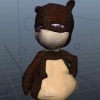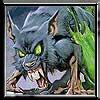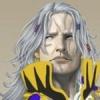First,
Okay, I'll bite. The player is a grey cube that can move around and jump in a 2D or 3D maze. The player also has keys to resize themselves one magnitude larger or smaller. The maze is fractal, so there are paths and enemies (grey cubes) at all magnitude levels smaller than the beginning size. When you're bigger you can stomp enemies and travel quickly, when you're smaller you can squeeze through tiny gaps in the walls. Preferably it is not possible to complete the maze using one size only.
I like the idea, it is original and fresh, it offers some very fun puzzle designs.
Some questions.
Is fractal mazes completely necessary to this design, or is it feature that would be really enjoyable? If so why is it necessary and what does it enhance about the game play? As opposed to just having level's designed out.
As well it seems that being the largest size would be the best options at all times, what reason other then to fit through small holes is there to change size?
And finally what elements of this game are fun? Or rather what mechanics make the game fun? ( I can already see that changing size to solves puzzles is a really unique concept for level and puzzle design. Why are the enemies fun or rather what do the enemies offer to the player in terms of challenge and why is that fun. The goal of this is to isolate individual mechanics and analyze why they are fun not because this will ultimately the overall gameplay.)
Second,
The player is a grey cube that can change to different shaped grey cubes. The enemy is also a grey cube thay change to different grey cubes. Each shape of grey cube has strengths over some grey cube shapes and weaknesses against other grey cube shapes. Grey cubes have a large array of shapes they can choose but a limited array is chosen between each battle.
I like the idea, it seems to promote tactical thinking about what shapes that you bring into battle.
What range of shapes are there?
How does battle happen? What does the player do in battle? What is fun about battle? (maybe run thru a mock battle of what it might be like, just so i have a better understanding of what battle is)
How many shapes can you bring into battle?
What is fun about having different shapes battling different shapes?
What is fun about having a limited amount of shapes you can bring into battle?
Thirdly,
This one's 2D, side-scrolling, with minor platforming. The player assumes the role of a grey cube, with an assortment of different weapons. The player picks up key grey cubes and uses them to solve logical puzzles, and receives storyline information by grey cubes that they recover from around the levels. Sometimes the player has to jump over small chasms, swim through flooded areas, navigate dark rooms by grey cube, or repair grey cubes with items found in about the level. There are numerous types of enemies, some quick and weak, some strong and slow, some ranged, some melee, some a mix of everything. Balance between the ability and wisdom in fighting enemies (They are no longer in the room and thus it is safe to travel through) and the wisdom in avoiding them (conserve grey cubes, grey cubes, and grey cubes) is part of the scheme of the combat system. The player is capable of jumping over small enemies and, with proper timing, has the ability to perform a "juke" that will place them on the other side of larger enemies (the player can also vault over some foes if they stun it with their grey cube weapon). The player can jump higher and farther with momentum, and can slide with sufficient running speed, allowing them to bypass many types of enemies if they execute the maneuvers correctly. The player can recover their vitality slowly over time if they have [grey cubes] in stock, or can immediately heal with a [grey cube]. There are boss grey cubes that require tactics and logical thinking, as well as boss grey cubes that require reflexes and precision. There are many areas that the player is not required to go, but will be rewarded for doing so (though grey cubes, "ammunition" to use grey cubes, or plot grey cubes). It's up to the player if they want to experience the plot in its entirety or simply complete the levels.
Okay there is lots of different mechanics going on in this design. It sounds a little complicated but overall could be a fun rewarding experience.
I have a few questions.
It seems that the players grey cube has many movement type abilities that are focused moving past the enemies( sliding, momentum jumping and juking) thus making enemies part of the platforming experience? Does this make platforming a major part of the game? If so why? If not why? Why is that fun? What does it add to the game by having these abilities are they necessary? why?
Sometimes the player has to jump over small chasms, swim through flooded areas, navigate dark rooms by grey cube, or repair grey cubes with items found in about the level. Why are these fun? Are all of them necessary? (if we remove one of them does the overall game suffer) Are some more important then others? If so why? Overall what do having these different area's or goals offer the player experience.
Is receiving storyline information by grey cubes important to the game play itself ? Does it change how the player plays the game itself? Why or why not?
It would appear that there is some sort of resource management in the form of Healing over time [grey cubes] and Full health [grey cubes] as well as Ammunition [grey cubes] and Plot [grey cubes]? ( correct me if i am wrong on the fact of resource management in the idea of different [grey cubes] that the player uses over time)
Could you explain why each one is important to the game? Are some more important then others? Is it necessary to have all the different types [grey cubes] ? Why or why not? What aspect of the game suffers if we remove them?
What do the different types of enemies do? What type of experience do they create for the player? Can the player kill the enemies or only just stun them? What do you mean by wisdom? ( I could take it to mean puzzle solving around enemies but i don't want to presume)
You mention ammunition [grey cubes] for multiple weapon's what are these multiple weapons? What do they do? How does it change the game play experience?
I think i asked you the most questions of anyone ( you wrote the most
Finally,
The goals that i am trying to find out with these questions: Mostly why each choice was made and how it will effect the game play experience. It is okay to not have an answer yet for all of these questions but these are important to design. Every choice we make as a designers must have a reason and a why to it. Also a lot of these questions are repetitive in an attempt to really drill down into the core of each mechanic.
It is my belief that by starting with a strong core mechanic and building sequential mechanics around that, that the overall game will be stronger and we as designers will have a better vision of what the game is truly about.
If anything i have asked is unclear please ask me to clarify . Also i can think of one answer for each of these questions. I hesitate to just jump in and tell you what i think and would prefer to draw it out of you so we can discuss the reasons why we are making these decisions.
To give you a bit of heads up in the coming weeks of some of the things i might ask you about your design are the game design pillars of your designs and perhaps the mission statement of your design.
see this link for the definition of pillars that i will be using. http://technicalgame...04/pillars.html
As well i will in the next few weeks i will want to talk about the aesthetics in each of these designs. Please read http://www.cs.northw...hunicke/MDA.pdf
Please read specifically the part on aesthetics *note: their are actually nine aesthetics the ninth being competition.
Thanks! You guys are doing great!
PS: Others please ask questions, but do it in a format that is critical asking why or how is awesome. We don't know exactly what the designers vision is and it is infinitely more valuable to understand the why and how of a designers choices rather then just telling them what you think. As we begin to understand others reasoning for their choices, it allowing us to asking more probing questions and possible undercover holes in the design, in which the designer will have to deal by iteration upon the design.
Ultimately leading us to being better designers and creating better games.








